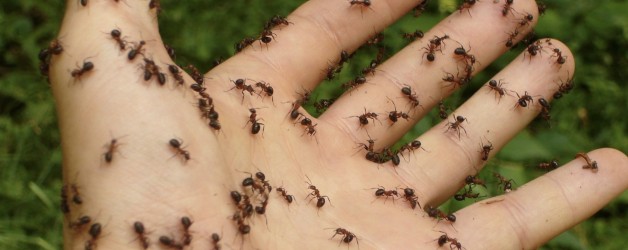Okay so we’re halfway though the year already and with the recent warm temperatures I feel like I have spoken to clients about Ants more than I have spoken to my children about…well anything (apart from maybe Fortnite).
With the increase in temperature comes the increase in insect activity and unless you’ve been living on a boat in the middle of the sea, I can be pretty sure you’ve noticed the onslaught of ants invading your home and gardens.
Today I’d like to shine some light on what, why and how we get rid of our little six legged crumb snatchers!
For the sake of time, my sanity and your attention span I won’t go into all of the UK’s various Ant species here but I will talk about the top 3 biggest contributors to disrupted summer bbq’s.
Coming in at number one is our common favourite the Black Garden Ant (Lasius niger), second on the list is our acid spitting (not kidding) brown/ red coloured Wood Ant (Formica rufa) and last but by no means least to this list is the newest, non-native species of Ant the Invasive Garden Ant (Lasius neglectus).
Summer-invading Ant facts;
Ants are social insects which simply means that they live in large colonies with a strict and well organised structure to ensure all tasks are completed for the greater good of the colony as a whole.
There are many roles within the colony from protecting the nest from invaders and/or other ants, rearing the brood or simply foraging for food but every role is equally as important as the next to ensure their survival.
Did you know? – Ants have an interesting feeding behaviour called trophallaxis! This mean that they share food by passing it from one Ant to another, I’ll explain why that’s important to know in a minute.
Black Garden Ants (Lasius niger)
This is probably the most recognisable and/or common of the three i’ll talk about here. Their nests can occur in Walls/ Pavements/ Patios/ Tree stumps and even open pasture lands – so pretty much anywhere.
This species is aggressive and will attack other Ants and insects if they stumble too close to the nest and they will eat anything from plant nectar to aphids, other insects to that sweet tasting residue left on your discarded lolly stick.
Invasive Garden Ant (Lasius neglectus)
Okay so here’s where it gets difficult to the untrained eye, L.neglectus can look very similar to the Black Garden Ant but one of the main difficulties when it comes to control of this Ant is that different to L.niger which has only one queen, L.neglectus can have multiple and this means colonies can split and spread really easily if they feel threatened by, you know, perhaps someone getting a boiling kettle of water out!
One colony in Hidcote, Gloucestershire was estimated to spread across 9 hectares!
Wood Ant (Formica rufa)
This is a common woodland ant which makes large mound-like nests are very noticeable on trails when out walking. This species is red/ brown in colour and can be very aggressive and has a wonderful party trick of being able to spit acid to defend itself. Foraging trails can extend up to 100m from the nest so be careful not to sit on one or Ants in your pants will be the least of your problems, but acid on your bits doesn’t quite have the same ring to it!
Okay so lets now get to the important part… control!
For those of you that were paying attention above I’ll now get to trophallaxis and how that’s a key piece of information when it comes to eradicating a colony.
Gel baits which are inside the ant bait stations similar to the ones commonly found at DIY stores work by providing a toxic meal which they will consume and then share with the other Ants in the nest including the queen and brood ensuring complete control.
Although its quick and easy to get the kettle out or even spray the ants with whatever noxious concoction you’ve found online, but the reason this will be ineffective is because up to 90% of the colony will remain underground and away from reach.
In short, don’t do it, it may give you short term relief it will also be short lived.
Baits are boss.
When selecting a bait station, look for one with the active ingredient fipronil in it, its a tasteless insecticide which is fantastic at control.
As always, if you’ve given it a go yourself and are struggling, contact us and we’ll be happy to come and treat them for you.
Ramblings of a Rat Man over for another day.
DJ


